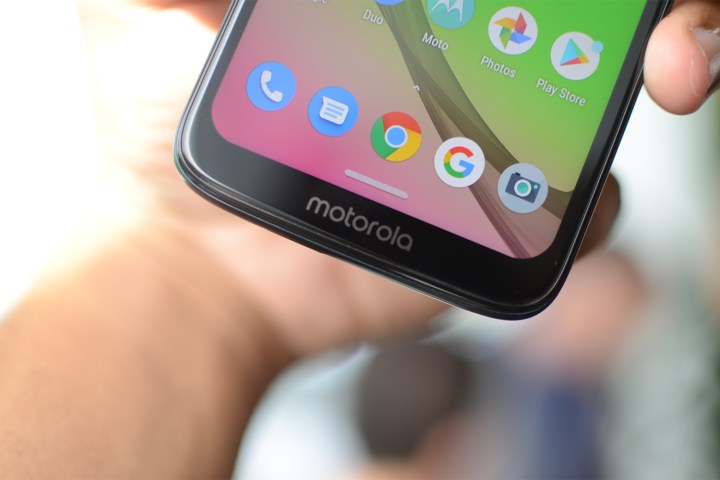
Looking for a phone that won’t break the bank? Motorola recently unveiled three smartphones as part of its 2019 Moto G-series range. These include the Moto G7, the Moto G7 Play, and the Moto G7 Power. The G7 Power is a new entry in Motorola’s G-series, replacing the Moto G Plus that’s usually an option. The Moto G7 Plus does exist though, but it’s not arriving on U.S. shores.
Here’s everything you need to know about Motorola’s latest additions to its Moto G7 lineup.
Price and availability
The
The standard
The G7 Play is also available from Motorola, Best Buy, B&H, and Amazon. You can also get Motorola’s cheapest G-range phone from Boost Mobile for just $1 upfront (excluding taxes) and $8/month for 18 months. Be quick though, the offer only stands until the end of May.
The G7 Power and its behemoth of a battery is available from Motorola, Best Buy, B&H, and Amazon. You can also grab the
Moto G7
The flagship phone of the three is the
Key Specs
- CPU: Qualcomm Snapdragon 632
- Memory: 4GB
- Storage: 64GB
- MicroSD storage: Up to 512GB
- Screen size: 6.2 inches
- Resolution: 2270 x 1080
- Connectivity: Bluetooth 4.2
- Battery: 3,000mAh
- Size: 157 x 75.3 x 8mm
- Weight: 6.07oz
- Operating system: Android 9.0 Pie
The camera specifications are similar to last year’s Moto G6, with a dual-sensor camera on the back that packs one 12-megapixel sensor and 5-megapixel depth sensor. On the front, the camera sits in at 8 megapixels. Motorola is touting a new Hyperlapse feature of its camera, which allows you to convert already-shot footage to a fast-motion hyperlapse video. Then there’s “Auto Smile Capture,” which automatically takes a photo when it detects that you’re smiling. There’s also High-res Zoom, which delivers better looking photos when you zoom in digitally. The camera has the other usual features we’ve seen on other Motorola phones like Portrait Mode, Cinemagraph, and Spot Color.
There are a few things that Motorola could have updated for this device. The phone only supports Bluetooth 4.2, but Bluetooth 5.0 has been out for a while and offers valuable improvements, and there’s still no NFC, which is pretty disappointing as that means you can’t use any of these phones for contactless payments via Google Pay.
Software-wise, the phone ships with Android 9.0 Pie, and is close to stock Android, in that it’s clean and uncluttered, and there’s no Motorola “skin” layered on top of
Moto G7 Play
- 4. Moto G7 Play
The
Under the hood, the phone also boasts a relatively powerful Qualcomm Snapdragon 632 processor, but has 2GB of RAM instead of 4GB, and 32GB of storage — though there’s a MicroSD card slot to expand on that space. The battery, like on the standard
The camera is a little bit different too. Instead of a dual-sensor rear-facing camera, there’s a single one. It’s a 13-megapixel lens with an aperture of f/2.0. The front-facing camera is 8 megapixels with an aperture of f/2.2. You won’t get the new Auto Smile Capture feature on this device — if you want it, you’ll need the standard
Moto G7 Power
Need a device that can get you through a little more than one day of use? The
Key Specs
- CPU: Qualcomm Snapdragon 632
- Memory: 3GB
- Storage: 32GB
- MicroSD storage: Up to 512GB
- Screen size: 6.2 inches
- Resolution: 1520 x 720
- Connectivity: Bluetooth 4.2
- Battery: 5,000mAh
- Size: 159.4 x 76 x 9.3mm
- Weight: 6.98oz
- Operating system: Android 9.0 Pie
Like the other two
Perhaps the real reason to buy this phone, however, is the fact that it has a 5,000mAh battery, which Motorola claims should offer 60 hours of use. It does add to the thickness a little — the phone is 9.3mm thick — but for those that want a bit of extra juice, it may not matter.
The camera on the phone is a single-sensor camera that comes in at 12 megapixels with an aperture of f/2.0. On the front, there’s the same 8-megapixel camera that you’ll find on the other
Moto G7 Plus
Motorola has made the
Key Specs
- CPU: Qualcomm Snapdragon 636
- Memory: 4GB
- Storage: 64GB
- MicroSD storage: Up to 512GB
- Screen size: 6.2 inches
- Resolution: 2270 x 1080
- Connectivity: Bluetooth 4.2
- Battery: 3,000mAh
- Weight: 6.07oz
- Operating system: Android 9.0 Pie
At first sight, the
But the major changes are around the back of the device. Like the
But as we’ve mentioned, it’s not coming to the U.S. for the moment. Instead, the
Updated on April 26, 2019: The
Editors' Recommendations
- Does the Moto G Power have NFC?
- You won’t believe how I improved my phone’s battery life
- 10 years ago, this small Android phone changed smartphones forever
- If you like cheap phones, you’ll love these 2 new Moto G options
- Moto G Power 5G adds a flagship feature to a budget phone














